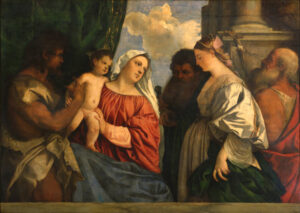On the evening of July 29 1605 the young notary Mariano Pasqualone, a native of Accumoli, shows up with a head wound at the offices of the criminal court in Rome to file a complaint. What he tells is that while walking in Piazza Navona “son stato assassinato da Michelangelo da Caravaggio pittore. Mi sono sentito dare una botta in testa dalla banda di dietro, che io sono subbito cascato a terra et sono restato ferito in testa, che credo sia stato un colpo di spada“1. To the presumable question if he was sure he had identified his attacker, Pasqualone answers “non ho da fare con altri che con detto Michelangelo, perché a queste sere passate havessimo parole sul Corso lui et io per causa d’una donna chiamata Lena che sta in piedi a piazza Navona, che è donna di Michelangelo. E di gratia vostra signoria mi spedischi presto acciò me possa medicare“.2.
The Lena to which the poor Mariano refers is none other than Maddalena Antognetti, a faie level courtesan in those years and in all probability sentimentally linked to Caravaggio, of which with a not very likely hypothesis it has been said for a long time that it could have been the model used for the Madonna of Loreto also known as Madonna dei Pellegrini in the Cavalletti chapel in S. Agostino.

Much has been written on this splendid altarpiece: on the “noise” (though variously interpreted) aroused by its unveiling to the public, on the clothes less than discharged and the bare and dirty feet of the pilgrims, on Lena’s profession and on the presumed discovery of the main door in the frame of which her statuesque figure stands out3. The aspect on which we usually dwell the least is that of the iconographic sources from which Caravaggio would have drawn.
It is well known that the painter was not used to the ancient repertoire, but this time, at least in part, he must have made an exception, in fact the lower part of the virgin’s body seems to have been taken over by the so-called “Thusnelda”, that is the not too refined statue of the Roman age depicting a germanic princess taken prisoner.
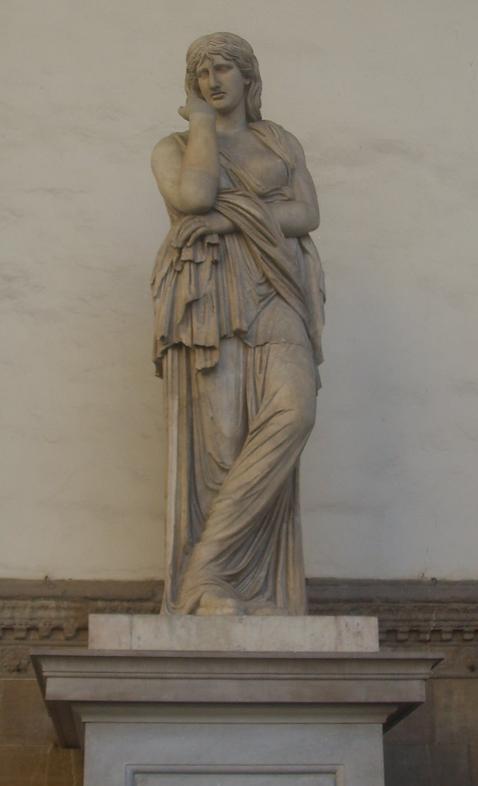
The statue has been on display under the loggia of Piazza della Signoria in Florence since 1789, but it had spent the previous two centuries in Rome in some niche in Villa Medici, a place that Caravaggio must have frequented since one of his very first protectors was Cardinal Francesco del Monte, for a long time a Medici man in the papal court.
Another hypothesis is that it comes from the Peitho of the Aldobrandini Wedding, a fresco from the Augustan age found in Rome a few years earlier and immediately highly regarded and celebrated in the Roman art and antiquarian circles.

Few doubts exist about the fact that the unusual pose of the Virgin’s legs came from one of these sources, but the rest? Someone wanted to see in the general layout of the canvas a theme taken from a print by Cherubino Alberti (who probably knew Caravaggio) in turn derived from an Adoration of the Magi by Rosso Fiorentino.
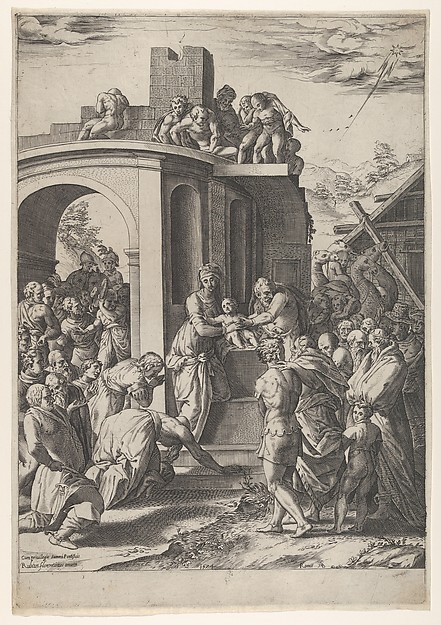
But in my opinion there is at least the possibility that he came from a completely different work and environment and this is where the unfortunate Pasqualone, or rather the chain of events that his dispute with Caravaggio unconsciously sets in motion, returns to the scene. Perhaps that same evening of July 29th a witness gives a description of the attacker. Actually more than a description we could define it as the impression of a figure seen little and badly while he was moving away in the darkness after having wounded the notary: “rivoltatomi di dietro ho visto uno con un’arme sfoderata in mano che mi è parso una spada o pistolese, che subito si è rivoltato, ha fatto tre salti et è voltato verso il palazzo dell’illustrissimo cardinal Del Monte, cioè in quel vicolo, che portava un ferraiolo negro in una spalla sola“4. It is not much that but, accomplice the indication of the palace5, is enough to get Caravaggio in trouble once again.
Perceiving that his connections this time would not have been enough to avoid him serious effects (Pasqualone was an official of the Cardinal Vicar of Rome
6, not just any street boy), decided to run away and seek refuge in Genoa. The choice of the city was not accidental: in addition to the advantages of the trip by sea, which would have protected him from possible ambushes, Caravaggio in Genoa could count on the presence of Giovanna Colonna, wife of Andrea II Doria as well as granddaughter of Costanza, Marchioness of Caravaggio and her tireless protectress with whom the Merisi family had longstanding relationships
7. As if that were not enough, in the city were then present both Ottavio Costa and Vincenzo Giustiniani, already admirers and clients of Caravaggio in his early Roman years.
The painter stayed in Genoa less than a month. We know this from a letter that Fabio Masetti, Este’s ambassador in Rome, sent to Modena on August 24th and in which we read that “Caravaggio appeared in Rome for the hope of peace”, a hope evidently well placed since a few days later Pasqualone accepted the painter’s apology (perhaps lubricated with some money as compensation) and withdrew the lawsuit. Masetti kept the Este court informed, not because of his whim but because Duke Cesare was probably getting nervous since he had commissioned and partly already paid Caravaggio for an altarpiece for his chapel of which there was still no news and for which the conduct of the painter, “extravagant brain”, did not allow a glimpse of a next solution.
In short, Caravaggio’s stay in Genoa was resolved in a sort of flash visit, but perhaps it was enough to admire a painting exhibited in the palace of one of the most rampant and wealthy Genoese families of fresh nobility, the Balbi.
The painting in question was the Madonna and Child and Saints Catherine and Dominic with the donor, also known as the Holy Balbi Conversation, painted by a young Titian around 1513.
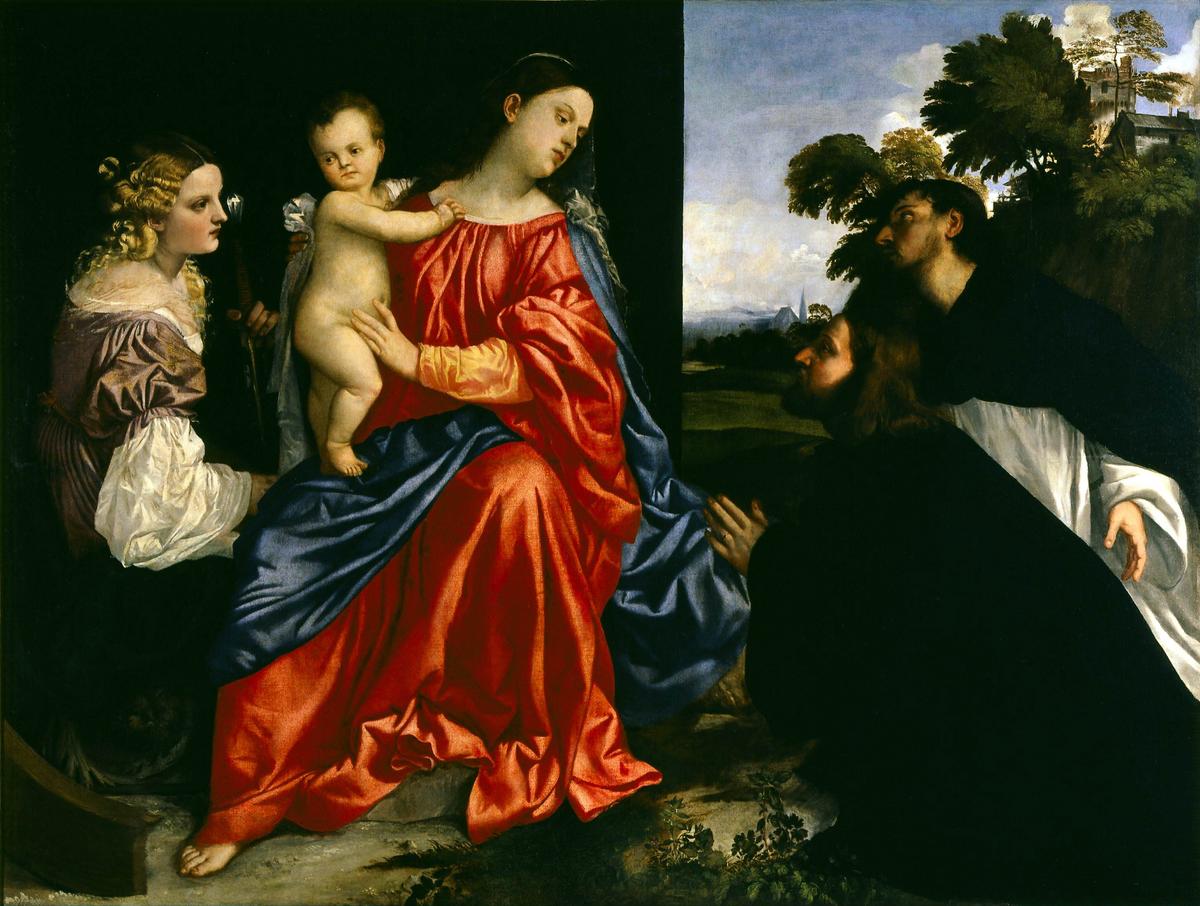
Even if the first direct testimony of his presence in Palazzo Balbi dates back to an eighteenth-century inventory8, it is believed that there was exposed since the sixteenth century
9 so it might not be inappropriate to imagine Caravaggio brought to visit the excellences of the city collections by one of his patrons.
The possible points of contact between the Madonna dei Pellegrini and the Sacra Conversazione Balbi are various: the child held aloof, the look from top to bottom (more haughty, almost contemptuous, in Titian, a little more placid in Caravaggio) and that sort of threshold against which the Virgin stands out and which serves to mark the border between the two worlds, threshold that Titian realizes with a scenographic black background and Caravaggio, accomplice the theme of the painting, with the door of the house of Mary
.
But seeing the two scenes side by side is more effective than any explanation:
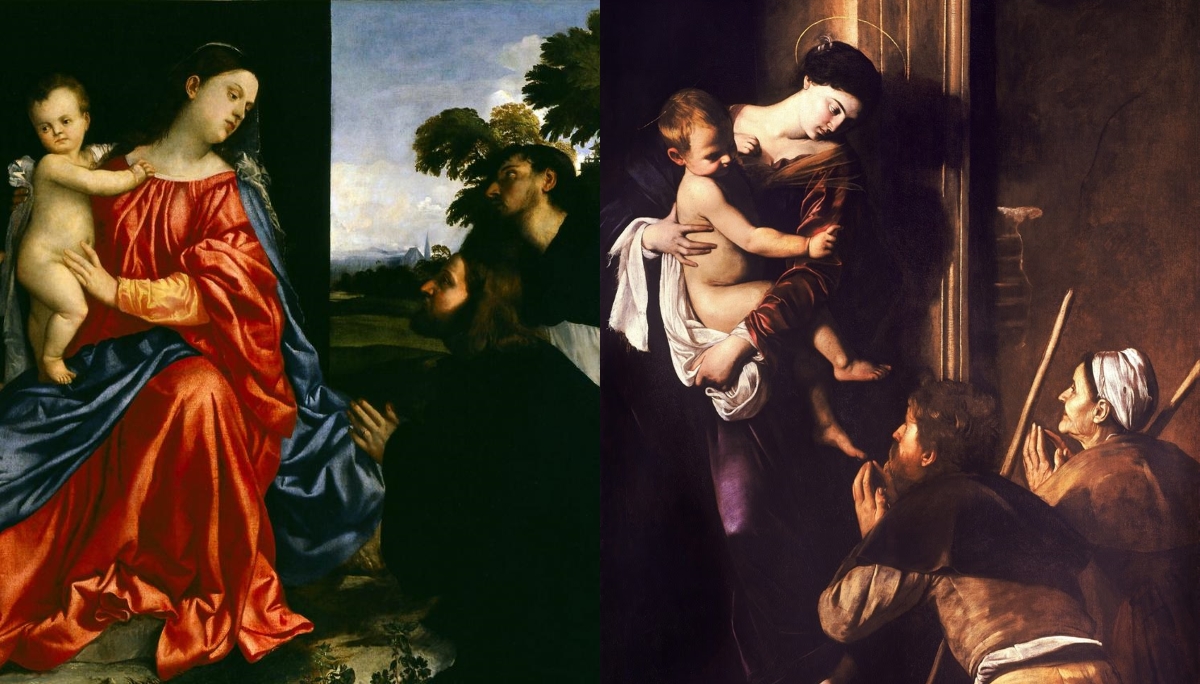
According to the most accredited hypotheses the Madonna dei Pellegrini was painted between the summer of 1605 and the very first months of 1606. The probable deadline is known to us as the donation of the Augustinian friars to Cardinal Scipione Borghese of the previous altarpiece (“L’immaggine antica della Pietà che già stava al altare della Fiammetta hora delli Cavalletti”
11) is dated March 2, 1606. I say “probable” because we actually know, always from Masetti, that the eventual absence of the altarpiece could also not constitute an insurmountable problem for its inauguration. In another letter of September 3 to G.B. Laderchi, very influential advisor of Duke Cesare, in fact Masetti states: “M’adopero per l’indulgenza a preti che celebrarano nella cappellina di Sua Altezza, delli quadri della quale bisogna pensare quando vorranno i pittori, né più sperargli per la prossima festa della Santissima Natività“12 as if to say “If we wait for the painters [there was also Annibale Carracci] we’ll never inaugurate it, so go ahead”. In short, it was certainly not a usual practice but not even unthinkable.
Returning to the paintings in question, the fact that the Virgin of Caravaggio is so humbler and more earthly than her Titian colleague is not surprising. Because of the very different use of the first altarpiece and the private devotion of the second, because of the storm of the Reformation and Counter-Reformation that took place in the middle and because of the different sensibility and milieu of the two artists, the Madonna dei Pellegrini could not have been the same as the Sacred Conversation, but Caravaggio could have been equally struck by the geometry of the glances and figures that underlie the latter in order to present it again in a close circle, and skillfully interpolated with the pose of Thusnelda, who had just returned to Rome.
A last element that could have some importance is the sketch that Antoon Van Dyck drew from Titian’s work. Not unlike many of his Nordic colleagues, Van Dyck came to Italy from his native Antwerp in 1621 and stayed there for six years, travelling almost all the way, but also based in Genoa for long periods. Of his stay there is a block of sketches now preserved at the British Museum and in one of the pages, among the many dedicated to Titian (for whom Van Dyck had a strong admiration), there are three heads evidently copied from the Holy Conversation. But there is a problem: they are drawn “mirror-like” which means that they were sketched based on a print and not on the original13. At first glance one could think that in those years the Balbi owned the print and not the original, but there is a detail that could perhaps overturn the issue.
Van Dyck in Antwerp had got to know Giovanni Agostino Balbi well, that is, the man who took care of the business of the genoese family in Flanders, a great collector and art lover. Balbi had also had a portrait made, now lost, and had encouraged Van Dyck to come to Italy, offering him logistical support and numerous commissions (the Balbi would be the painter’s first clients in Genoa and may even have hosted him on several occasions). If Balbi had Titian in Genoa, i.e. where Caravaggio should have seen him about fifteen years earlier, there is nothing strange in hypothesizing the presence in the Antwerp house of a reproduction of the masterpiece exhibited in his palace and that Van Dyck could have copied it there, before leaving, and not in Italy. At this point one might wonder why in the notebook there are no sketches of the original but the missing pages are many and it is very possible that the sketch was made and then detached to be sold separately by one of the various owners over the centuries (a practice far from rare) and then maybe lost or burned.
Appendix
If much has been written about the Madonna of the Pilgrims, the Holy Conversation cannot be said the same. It’s known as the Sacred Conversation Balbi or Madonna Balbi and given that it has remained for centuries in the Balbi palaces (from an unspecified point in the 16th century to 1952, today it is on display at the Magnani Rocca Foundation in Parma) it would seem logical to attribute its name to the Genoese family if it were not for the news available on the web that for the most part tend to identify the donor with an unspecified Venetian patrician named Domenico Balbi. If the name is in all probability inferred from the San Domenico who accompanies him introducing him to the Virgin, the surname is a little more difficult to attribute.
In the genealogy of the various branches of patrician Balbi that I have consulted I have not found a living Domenico in the years of the painting nor any connection with their namesake Genoese, but there was another Balbi family that has more interesting elements. These were the Balbi so-called “timber”, a bourgeois and wealthy family that since the early sixteenth century was active between Venice and Cadore in the timber trade. The fact that Titian had capital invested in that trade, and that he could therefore know one of the most active families in the sector, is not surprising, but in the Balbi family we are talking about there were four brothers in those years: Domenico, Paolo, Giovanni and Baldissera, sons of Piero. Gaspare, one of Giovanni’s sons, had married a cousin of Titian and between the ’50s and ’70s he acted as an intermediary on behalf of the painter. Another piece of information we have is that the Balbi brothers owned a small collection of paintings, some of which were perhaps Titian’s own.
So we have a Domenico Balbi active in the years of the Holy Conversation, with a good financial availability, a propensity for collecting and a connection with Titian. The donor of the painting wears a sort of black toga typical of the nobility and we know for sure that the Balbi we are talking about did not belong to the homonymous patrician family, but in the famous De gli habiti antichi, et moderni di diverse parti del mondo published in 1590 by Cesare Vecellio (a relative of Titian) we read that “This ordinary and common dress in all the Venetian nobility […] is used not only by the nobility but by citizens and by anyone who is pleased to wear it, as almost all the doctors, lawyers and merchants do, and all of them are happy to dress in it because […] it brings with it to the others also great reputations”.
Apparently, therefore, nothing would prevent us from thinking that Domenico asked his young and evidently gifted acquaintance a painting of private devotion to keep at home. What remains to be explained is how a few decades later, with an incredible coincidence, the painting ended up in the hands of another Balbi family settled hundreds of miles away and without apparent relations with his namesake Venetians.
- “I was assaulted by Michelangelo da Caravaggio painter. I was hit in the head by the gang in the back, that I fell to the ground and was wounded in the head, which I think was a sword wound”
- “I have nothing to do with anyone but Michelangelo, because these past evenings we have had words on the Corso lui et io because of a woman called Lena who is standing in Piazza Navona, who is Michelangelo’s woman. And your lordship please send me away soon so that I can medicate”
- From a quick search on the net one can easily obtain more material than one might normally be willing to read (especially on a monitor). The Wikipedia entry is a good summary and has the merit of providing, albeit in a very succinct way, an explanation of the theme of bare and dirty feet, a theme that far from being a whim of the artist has instead known precedents in Lombard painting and religious milieu of which Caravaggio and many of his protectors and patrons were more or less conscious advocates
- “I saw a man with an unsheathed weapon in his hand who seemed to me a sword or a dagger, who immediately turned around, made three jumps and turned towards the palace of the illustrious Cardinal Del Monte, that is in that alley, carrying a black mantle in one shoulder”
- Caravaggio had been in fact to the dependencies of the cardinal Del Monte from 1597 to 1600. Del Monte had helped him by commissioning several canvases as well as procuring him “external” works such as the Contarelli chapel in San Luigi dei Francesi, and had even hosted him for a long time in his palace which probably explains the deduction of the papal guards
- Exactly his job had pushed him against Caravaggio. In fact, among Pasqualone’s duties, there was also the notification of injunctions to keep a less scandalous conduct to those suspected of illicit love and/or adultery: in that period Maddalena Antognetti, I do not know if after marriage or more uxorio and maybe not too happily, was living together with a certain Gaspare Albertini with whom she had a son and the altercation reported in the testimony as the cause of the subsequent aggression would have happened just while Pasqualone, in the exercise of his duties, ordered Caravaggio in the name of the law to stop harassing the woman. Let’s not forget that a few years earlier the pope, in contempt of popular sentiment and in a pretty controversial case, in order to give a strong signal to the extremely violent mood that reigned in the city, had not scrupled to have Beatrice Cenci beheaded in front of a rather angry crowd
- Costanza Colonna, daughter of Marcantonio, one of the winners of Lepanto, had ended up contracting, at a very young age, an exquisitely political marriage with the Marquis of Caravaggio for whom the painter’s maternal grandfather, Giovan Giacomo Aratori, a member of the minor local nobility, had worked for a long time as a trusted administrator. Aratori’s closeness to the family is made good by the fact that on January 14, 1571 the Marquis was present as best man at the wedding between his daughter Lucia and Fermo Merisi, future parents of Michelangelo. The tenacity with which Costanza Colonna always protected the painter, who was only 16 years younger, can probably only be explained by a sincere friendship dictated by the fact that perhaps Costanza for the little Michelangelo ended up being more like an older sister. For those who would like to know more about the subject is discussed at length in this article (sorry, it’s in italian but with an online translation should become quite readable)
- Such a relatively late testimony could also not have a particular meaning about the dating of the Genoese stay since even contemporary paintings that never moved from the city appear officially inventoried for the first time in the same years
- Filippo Pedrocco (1950-2014) openly supports it in this note for an exhibition held in Australia in 2002
- Titian will realize again a few years later something quite similar in the Madonna and Child between Saints Baptist, Paul, Magdalene and Jerome today in Dresden
- “The ancient image of the Pietà that used to stay on the altar of the Fiammetta now of the Cavalletti”.
The previous altarpiece was a Pietà painted by Jacopo Torni called the Indigo about a century before. Curiosity: the Fiammetta to which the document refers was Fiammetta Cassini, famous Tuscan courtesan stationed in Rome and known for her ties with such prominent figures as Card. Ammannati and Cesare Borgia. In short, the overly pious Cavalletti bought an altar whose previous patronage belonged to someone who today we would call an escort - “I am working for the indulgence of priests who celebrate in the chapel of His Highness, whose paintings we must think when the painters will make up their minds, nor hope for the next feast of the Holy Nativity”
- The print must have been of great quality because the heads look very similar to the original painting. There is a seventeenth-century reproduction of the painting which, however, due to its approximate quality, cannot be the one taken as a model by Van Dyck and that unfortunately is lost
